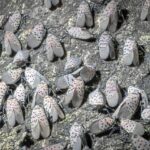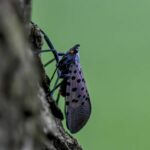Spotted lanternflies have invaded Pittsburgh.
After a few years of sparse sightings, the local lanternfly population apparently has exploded and the invasive species is being spotted across Southwestern Pennsylvania.
While not immediately dangerous to humans, the insects love to gorge on vegetation and swarm on trees, the sides of homes and all over patios.
Jake Milofsky, director of tree care at local nonprofit Tree Pittsburgh, said lanternflies have damaged some crops, particularly grapes, and the state wants to manage their spread. But, he added, lanternflies aren’t poisonous to people, they don’t bite and they don’t sting.
He said mainly they are annoying and can wreak havoc on enjoying outdoor spaces such as yards and porches.
“For the average homeowner, lanternflies are a nuisance, but they are not a catastrophic hazard,” Milofsky said.
How to deal with lanternflies?
There are multiple ways to eliminate the pests, as recommended by the Pennsylvania Department of Agriculture.
First and foremost, physically removing them is best. That can mean stomping the insects when they are in adult or nymph form and removing their egg masses.
Sandy Feather of the green industry team at Penn State Extension said the best way to stomp lanternflies is from the front, since the bugs can only jump forward.
Mike Zydel works for Rosato & Sons landscaping in Greenfield. The company specializes in lanternfly removal.
He said egg masses tend to be about 1.5 inches long. Egg masses are white and then can turn tan, Zydel said. They can be found on the side of trees, rocks or other structures such as decks, houses and outdoor equipment. If spotted, he said it’s best to remove them immediately.
“If you see them, you should try to kill them,” Zydel said.
Eggs are laid in the fall and hatch in the spring, according to Penn State Extension. They usually are protected by a mud-like covering and contain an average of 35 to 40 individual eggs.
Zydel added that egg masses can be found in hard-to-reach places, including high up on trees, so it is best to hire a professional in those instances.
When a yard becomes overrun by the flying insects, Zydel also recommends hiring a professional.
Zydel, who also hosts a podcast about Greenfield, said the neighborhood and much of the East End are covered in lanternflies. The nonnative species comes from China and first arrived in the United States in Berks County in 2014. Pittsburgh started to see the pests in 2019.
For a home remedy, Penn State Extension recommends circle traps, which use nets, bags and ramps to capture the spotted lanternflies humanely. Originally designed to capture pecan weevils, circle traps can be built or purchased commercially. They are installed on infested trees.
Sticky tape on trees has been effective at capturing lanternflies, but the Department of Agriculture said tape also can capture and kill other insects, even birds, so use with caution. Zydel adds that sticky tape also doesn’t work continuously.
“From what I have seen, you will catch some with the tape, but then the others will just start congregating there,” he said. “It is like their chill spot, like hanging out with a case of Iron City, listening to some jams.”
Zydel said professionals use pesticides that will kill lanternflies but are less harmful to other nearby plants and wildlife. He said pest control specialists also will find the source of the lanternflies, often on trees such as sumacs, which will be more efficient in wiping out localized populations.
“They love sumac, and they feed on that,” he said. “That is like a barbecue rib to them.”
The state also recommends homeowners remove Tree-of-Heaven trees, which lanternflies love to congregate on and feed. Tree-of-Heaven is an invasive species.
Feather discouraged the use of things such as soapy water or vinegar to kill lanternflies, because those products can harm plants and other animals. She recommends using the least-toxic registered insecticides to remove lanternflies.
Look before you leave
There are 51 counties in Pennsylvania under lanternfly quarantine, including Allegheny, Westmoreland and all of the Pittsburgh metro area.
The Department of Agriculture asks residents who live in a quarantined area to check for lanternflies on vehicles, trailers or outdoor items before moving within or out of quarantine areas. The department hopes this will slow the spread of the invasive species.
The state also asks residents to keep reporting spotted lanternfly sightings, even though the bugs appear to be ubiquitous now. Officials said reports help researchers better understand the insect and its movement, which will help refine management and treatment methods.
Zydel assuaged Pittsburghers that lanternflies are not a year-round nuisance. He said they only live for about a year, and they hate the cold. Lanternflies will migrate out of the region once the temperature drops.
“Once the frost comes, they will be gone,” he said.











